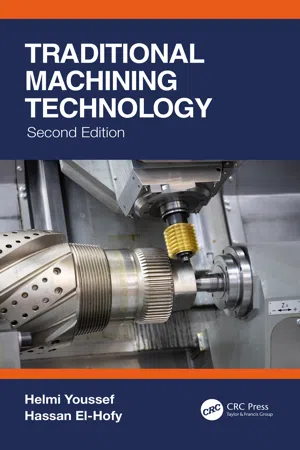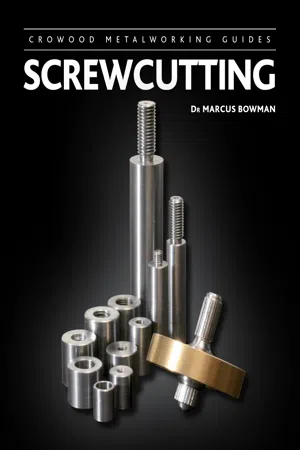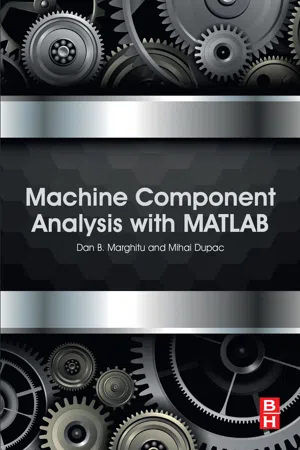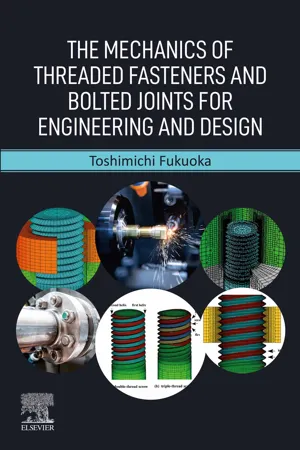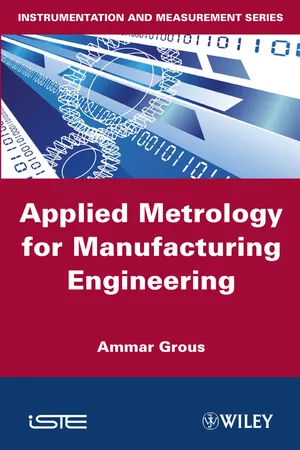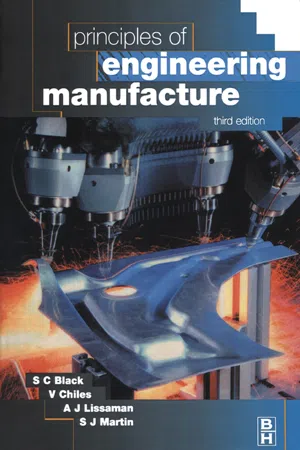Technology & Engineering
Screw Thread
A screw thread is a helical ridge wrapped around a cylinder or cone, used to convert rotational motion into linear motion or vice versa. It is a crucial component in fastening and assembly processes, providing a secure and adjustable connection. Screw threads are found in a wide range of applications, from machinery and construction to everyday items like screws and bolts.
Written by Perlego with AI-assistance
Related key terms
1 of 4
Related key terms
1 of 3
7 Key excerpts on "Screw Thread"
- eBook - ePub
Traditional Machining Technology
Machine Tools and Operations
- Helmi Youssef, Hassan El-Hofy(Authors)
- 2020(Publication Date)
- CRC Press(Publisher)
5 Thread-Cutting Machines and Operations5.1 Introduction
The production of Screw Threads is of prime importance to engineers, because nearly every piece of equipment has some form of Screw Thread. Machine parts are held together, adjusted, or moved by Screw Threads of many sizes and kinds. Screw Threads are commonly used as fasteners, to transmit power or motion, and for adjustment. Different thread forms (V, square, acme) and thread series (coarse, fine, and so on) are available. The Screw Threads used in manufacturing should conform to an established standard in order to be interchangeable and replaceable. The following terms (Figure 5.1 ) are used to describe the geometry of a Screw Thread:FIGURE 5.1 Thread terms.- Major diameter. The outside diameter and the largest diameter of the thread.
- Minor diameter. The inside diameter of the screw and the base of the thread. It is also called the root diameter .
- Pitch. The distance from one point on a thread to the same point on the adjacent thread. The reciprocal of the pitch is the number of threads per inch (tpi).
- Pitch diameter. The diameter of an imaginary cylinder whose surface would pass through the threads at such points as to make the width of the thread cut equal to the width of the spaces cut by the imaginary cylinder.
- Crest. The top surface joining the flanks of the thread.
- Root. The bottom surface joining the flanks of the thread.
- Flank. The slanted surface joining the crest and the root; the surface that is in contact with the nut.
- Lead.
- eBook - ePub
- Marcus Bowman(Author)
- 2015(Publication Date)
- Crowood(Publisher)
Fig. 2.7 ).These properties make the uniform helix an extraordinarily useful device to connect a shaft and a hole – so useful that it has become a key engineering device and forms the basis of the Screw Thread in all its forms.Fig. 2.8: A regular helix has a consistent radius and pitch.A helix is a curve in three-dimensional space (Fig. 2.8 ), and a circular helix has the same radius of curvature at all points, making this the most useful form of helix for use with a cylindrical shaft and hole.The pitch of a helix is the distance between two identically positioned points on adjacent turns of the helix, and a uniform (or ‘regular’) helix has the same pitch between all adjacent turns of the helix.The helix is a mathematical concept, and is a line with no thickness; so creating a practical helix around a shaft and hole in the real world means creating a ridge around the helix on the shaft, and a matching groove that follows the helix in the hole. The shape of the ridge and groove, and the pitch and diameter of the helix, define the threadform, which is, literally, ‘the form (or shape) of the thread’. The pitch and diameter of the Screw Thread are the pitch and diameter of the helix.Fig. 2.9: Two intertwined helices. The darker represents the projections above the surface of a shaft, and the lighter represents the groove cut into the shaft.Fig. 2.10: A sectional view of a meshed V-shaped nut and screw. The red lines define the edges of the pitch cylinder pitch.It would be possible to create a thread by wrapping a wire with a semi-circular section around a shaft (Fig. 2.2 ) and machining a matching semi-circular groove in the wall of the corresponding hole so that the projecting thread fits into the groove. But symmetry, together with the cunning of engineers, allows the shaft to carry both a projection and a groove (Fig. 2.9 ), while the hole contains a matching groove and projection to provide a greater depth of engagement in a practical thread. The whole arrangement is then symmetrical both on the shaft and in the hole (Fig. 2.10 - eBook - ePub
Mechanical Engineering Design
Third Edition
- Ansel C. Ugural(Author)
- 2020(Publication Date)
- CRC Press(Publisher)
shank or bolt length. Also, observe the washer face, the fillet under the bolt head, and the start of the threads. Referring to the figure, some terms from geometry that relate to Screw Threads are defined as follows.FIGURE 15.2 Hexagonal bolt and nut illustrate the terminology of threaded fasteners. Notes : P , the pitch; λ, the helix or lead angle; α, the thread angle; d , the major diameter; d p , the pitch diameter; d r , the root diameter; and L n , the nut length.Pitch p is the axial distance measured from a point on one thread to the corresponding point on the adjacent thread. Lead L represents the axial distance that a nut moves, or advances, for one revolution of the screw. Helix angle λ , also called the lead angle, may be cut either right-handed (as in Figure 15.2 ) or left-handed. All threads are assumed to be right-handed, unless otherwise stated.A single-threaded screw is made by cutting a single helical groove on the cylinder. For a single thread , the lead is the same as the pitch. Should a second thread be cut in the space between the grooves of the first (imagine two strings wound side-by-side around a pencil), a double-threaded screw would be formed. For a multiple (two or most)-threaded screw ,
whereL = n p(15.1) L = the leadn = the number of threadsp = the pitchWe observe from this relationship that a multiple-threaded screw advances a nut more rapidly than a single-threaded screw of the same pitch. Most bolts and screws have a single thread, but worms and power screws sometimes have multiple threads. Some automotive power-steering screws occasionally use quintuple threads.15.2.1 Unified and ISO Thread Form
For fasteners, the standard geometry of Screw Thread shown in Figure 15.3 is used. This is essentially the same for both the Unified National Standard (UNS), or the so-called unified, and International Standards Organization (ISO) threads. The UNS (inch series) and ISO (metric series) threads are not interchangeable. In both systems, the thread angle is 60°, and the crests and roots of the thread may be either flat (as depicted in the figure) or rounded. The major diameter d and root (minor) diameter d r refer to the largest and smallest diameters, respectively. The diameter of an imaginary cylinder, coaxial with the screw, intersecting the thread at the height that makes width of thread equal to the width of space, is called the pitch diameter d p - eBook - ePub
- Dan B. Marghitu, Mihai Dupac(Authors)
- 2019(Publication Date)
- Butterworth-Heinemann(Publisher)
.Figure 3.1 Helical thread and standard geometry of an external thread.Figure 3.2 Single thread right-handed screw, lead angle λ, and a double-thread left-handed screw.Metric or ISO threads are defined by M followed by the major diameter (mm) and pitch (mm/thread). Unified system threads are specified by the major diameter (in), number of treads per inch, and thread series: UNC Unified National Coarse, UNEF Unified National Extra Fine, UNF Unified National Fine, UNS Unified National Special, UNR Unified National Round (round root).3.2 Power transmission screws
The power transmission screws transform rotational into linear motion. They are used in screw jacks, tensile devices, presses, and precise machines. Fig. 3.3 shows the Acme and square threads that are employed as power transmission screws.Figure 3.3 Square and Acme threads.Fig. 3.4 shows the helix of a single square-threaded power screw with the pitch diameterd m, pitch p, and lead angle λ. For one turn,π, the lead of the thread, l, is the height of a right triangle and the “ridge” of the thread is the hypotenuse.d mFigure 3.4 Helix of a single square-threaded screw.A compressive force, F, which is parallel to the axis of the screw, acts on the power screw as shown in Fig. 3.4 . The following equations are applied for square threads.The force for lifting the load F isP r, and it is considered positive. The friction force acts against the motion of the screw and has the value, where μ is the coefficient friction and NF f= μ N - Toshimichi Fukuoka(Author)
- 2022(Publication Date)
- Elsevier(Publisher)
The jointed portions fastened by use of Screw Threads are generally called a bolted joint. In this book, therefore, the components clamped by various kinds of threaded fasteners are referred to as bolted joints. Basic forms and the usages of Screw Threads have been fundamentally unchanged since the Industrial Revolution. Nevertheless, threaded fasteners and bolted joints have continuously been important research objects in the mechanical engineering field. The biggest reason is that the external loads exerted on bolted joints are continuously being increased!1.2: Geometry and application purposes of Screw Threads
Screw Threads are roughly classified into two types, which are used for clamping and movement transmission, respectively. Most threaded fasteners such as bolts and nuts are basically used for clamping a number of parts composing machines and structures. On the other hand, Screw Threads used for movement transmission deliver various movements by utilizing their helical shape. They are further categorized into two types. One is used for generating large forces by making use of the action of the thread as an inclined plane, e.g., a jack for lifting heavy parts; the other facilitates the conversion between linear and rotational motions, e.g., feed screws built into machine tools. As a similar example, a micrometer provides a dimensional accuracy of 10 μm, in which a large rotation angle is converted into a small linear movement. A certain type of micrometer equipped with a digital display device provides higher accuracy of 1 μm.Fig. 1.1 shows Screw Threads of various forms. Triangular Screw Threads are the most commonly used when clamping multiple parts. On the other hand, trapezoidal Screw Threads are used for motion and power transmission. These types of Screw Threads are often called power screws [17] . The relationship between thread form and application purpose is explained in detail in section 3.2.4- eBook - ePub
- Ammar Grous(Author)
- 2013(Publication Date)
- Wiley-ISTE(Publisher)
If we need to interchange from one machine to another, Screw Threads should obey international conventions [ACN 84, OBE 96]. Screw Threads may be either right or left handed. Right-handed threads are the most common, especially in hardware fasteners. Left-handed threads are used exceptionally.Right-handed thread. A right-handed Screw Thread penetrates a threaded hole if it is turned clockwise. A nut gets closer to the head of the screw if it is turned in the same direction. If the screw is placed vertically, we would observe that the thread wound up going from left to right. If the screw is placed horizontally, the slope of the thread would correspond to the position of the thumb of a right hand. It is marked by the letters RH (right hand).Figure 8.7. Representation of thread directionsLeft-handed thread. The left-handed thread is identified by the letters LH (left hand). A screw with left-handed thread goes out of its threaded hole by turning clockwise. A nut moves away from the head if it is turned in the same direction. If the screw is placed vertically we observe that the thread wound up going from right to left. If the screw is placed horizontally, the slope of the thread corresponds to the position of thumb on the left hand.8.2. Helical surface for Screw Threads
A helical surface is characterized by the profile and the helix commonly called helical lead which is itself defined by the diameter of the cylinder Dpitch of the basic cylinder, constituting the Screw Thread. It is marked by its pitch P.Figure 8.8. Helical surface illustrating the development of a thread (ISO) at 60°The profile form is always read in the plane containing the axis of the helix. This form is dimensioned based on the helical lead. The helical surface is generated by the combination of rotational motion of the piece and translational motion of the tool shaping the profile and is located in the radial plane (λ).To find the helix angle for a given thread, we apply this formula:[8.1]This approach is classic but still in operation. It is necessary to refer to the diameter recommended by the standard. There are many other methods of obtaining a Screw Thread. There are various technological processes for obtaining external threads. To consult them, we should refer to the specialized technical literature [CHE 66, FAN 94, OBE 95]. - eBook - ePub
- V. Chiles, S. Black, A. Lissaman, S. Martin(Authors)
- 1996(Publication Date)
- Butterworth-Heinemann(Publisher)
By deforming a plain cylinder within the plastic range, threads can be produced without cutting away waste material. The flat plate method, rolling the blank under pressure between two suitably profiled flat plates, is a rapid method of producing bolts of relatively low quality such as ironmongery bolts. If the flat plates are replaced by cylindrical rollers (two or three according to the system employed) the rolling time can be extended and tougher metal worked to closer tolerances and better surface finish.Only a brief summary of screw-thread manufacture is possible here as an introduction to the more specialised topics of this chapter. Full descriptive treatments and explanatory diagrams will be found in books listed in the general section of the Bibliography.Screwed assemblies have more complex fitting requirements than plain assemblies but basic size, tolerance and fundamental deviation remain the controlling factors.14.2 Nomenclature and specification
BS 2517: Definitions for Use in Mechanical Engineering gives the standard definitions applicable to threads. Details of the principal thread forms are contained in:Because they are likely to remain in use for servicing purposes the following are also of interest:BS 3643: ISO Metric Threads.BS 4827: ISO Miniature Threads.BS 4846: ISO Trapezoidal Threads.BS 21: Pipe Threads for Tubes and Fittings.BS 84: Whitworth Form Threads.BS 93: British Association (BA) Threads.The well-known Machinery’s Screw Thread Book is another handy reference.Certain ideas about specification, tolerancing, gauging and measurement of Screw Threads of vee form (with a few minor exceptions) are common to all the above thread systems; these will now be explained with special reference to ISO metric threads.Figure 14.6 shows general features of Screw Threads of vee form. The nominal diameter is generally the major
Index pages curate the most relevant extracts from our library of academic textbooks. They’ve been created using an in-house natural language model (NLM), each adding context and meaning to key research topics.
Explore more topic indexes
Explore more topic indexes
1 of 6
Explore more topic indexes
1 of 4
